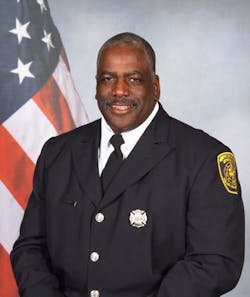Probe: Communications, Complacency, Training Factors in Cincinnati LODD
Operational errors, training, complacency and communications were among factors investigators cited in the 2015 death of Cincinnati Fire Apparatus Operator Daryl Gordon.
The department’s LODD report, released Thursday, wrote that “proper staffing, proper training and proper equipment to safely operated at any emergency incident should be our top priority.”
Gordon died March 26, 2015, after falling into an open elevator shaft at a four-alarm fire in a five-story building.
Fire officials noted crews had been to the same building a number of times for a multitude of issues.
“Just another food on the stove sometimes are actual fires and can lead to tragedy. Complacency can be a fire fighter’s worst enemy. Firefighters MUST remain diligent to professionally prepare for every incident and respond with a heightened level of awareness to effectively react to tactical challenges faced at every incident, even the most mundane,” investigators wrote.
While donning his SCBA to assist with a search, Gordon became separated from his crew. Clear conditions quickly changed.
His crew marked the elevator door with a black marker, “Do Not Enter Open Shaft.”
Although a district chief on the fifth floor was made aware of it, the caution was never broadcast over the radio, investigators determined.
Investigators wrote: “The Incident Commander should be notified immediately when an elevator is found in a building. It is important for companies and Command to realize the presence of an elevator to ensure it is controlled, searched, and, if hazardous, appropriate emergency notifications are made.”
At some point, Gordon opened that door with the defective interlock mechanism and fell to his death.
Crews didn’t know for more than 10 minutes that he was missing.
They found him wedged between the elevator car and shaft on the second floor. They were concerned he may fall further, so crews worked from different floors to rescue him.
He was transported to a hospital where he was pronounced dead.
The Hamilton County Coroner reported that the cause of death was asphyxiation due to compression of the chest with associated fractures. Additionally, they indicated the contributory causes of death were from blunt impact injuries with left pelvic fractures and scalp lacerations and contusions, according to the report.
“While there is nothing that can be done to change the outcome of the events on March 26, 2015, we can learn lessons from this horrific day. By accepting the findings of this report and promising to implement recommendations from the lessons learned, the Cincinnati Fire Department will pay the greatest tribute to Daryl by honoring his courage, dedication and sacrifice,” fire officials wrote.
Investigators said every firefighter in Cincinnati needs to embrace training and adhere to policies. It can no longer be business as usual.
“The largest and most comprehensive change to face the Cincinnati Fire Department will focus on reinforcement of basic firefighting skills and our actions during response to Structure Fires. Training will focus on the tasks and skills to be utilized every day to aggressively and safely combat structural fires. No longer will daily drill training by a company officer be sufficient. Fire fighters need to receive more formalized training than they have received most of their career. This training will focus on efficient engine company and ladder company operations. Once those skills are refined, frequent re-evaluation will occur.
“District Chiefs must play a vital role in company level training. This will be accomplished through training on incident command, scene size-up, fire scene operations, risk management, and forecasting and predicting the outcome of an incident, focusing not only on individual assignments, but other companies assignments as well…”
The investigators detailed the operation in the building as well as fire safety inspections conducted just days prior.
It was noted that some things have changed since Gordon's death. Among them:
- The Fire Prevention Bureau and City of Cincinnati Buildings and Inspections Department has identified buildings with similar elevators and fire companies were ordered to become familiar with these buildings and enter Premise History Reports.
- Anytime the fire department responds to an address for an elevator malfunction or rescue, the City of Cincinnati Buildings and Inspections Department is notified.
- 6020 Dahlgren was inspected and ordered to comply with all applicable fire codes before its reoccupied as a multiple dwelling.
- Fire companies were taken to the Fire Training Center to conduct hose deployment operations. There wasn’t any formal training on deployment or operations at fires, but this did allow for companies to “practice” hose evolutions.
“Daryl’s contribution as a fire fighter with the Cincinnati Fire Department and a friend to many will never be forgotten. Daryl dedicated his life to serving others and was a role model to many. Those who knew Daryl personally have forever been enriched by his energetic and caring dedication to life, his co-workers and the citizens he served. Firefighters from this point forward will benefit from the knowledge and experience gained as a result of this tragic event. Every fire fighter should feel a sense of pride in believing that Daryl’s sacrifice will help prevent others from experiencing this same type of tragic loss - not only in Cincinnati, but nationwide,” officials wrote.
